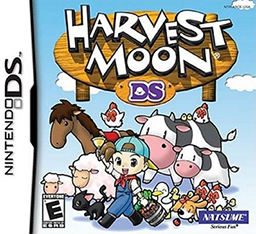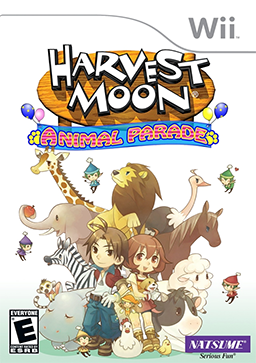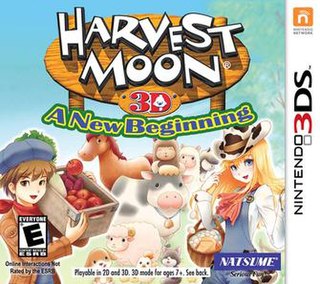The following outline is provided as an overview of and topical guide to agriculture:

Animal husbandry is the branch of agriculture concerned with animals that are raised for meat, fibre, milk, or other products. It includes day-to-day care, management, production, nutrition, selective breeding, and the raising of livestock. Husbandry has a long history, starting with the Neolithic Revolution when animals were first domesticated, from around 13,000 BC onwards, predating farming of the first crops. During the period of ancient societies like ancient Egypt, cattle, sheep, goats, and pigs were being raised on farms.
Story of Seasons, known in Japan as Bokujō Monogatari and formerly known as Harvest Moon, is an agricultural farming life simulation video game series created by Yasuhiro Wada and developed by Victor Interactive Software. Story of Seasons was the first game to be released under the new international series title of the same name.

Harvest Moon: A Wonderful Life is a video game that was released in Japan in September 2003 and March 2004 in North America for the GameCube. It was developed and published by Marvelous Interactive in Japan, and is part of the long-running Story of Seasons series of video games. The GameCube version offers connectivity with the Game Boy Advance game, Harvest Moon: Friends of Mineral Town.

Harvest Moon: Friends of Mineral Town is a video game for the Game Boy Advance, developed and published by Marvelous Interactive. It is the first Game Boy Advance game of the Story of Seasons series, and is a remake of Harvest Moon: Back to Nature. It was first released in Japan in April 2003, in North America in November 2003, and in Europe in March 2004. Many critics praised it as the best entry of the series, combining elements from the best-selling console entries and introducing many notable series staples. It was later released on the Virtual Console for the Wii U in June 2015.

Harvest Moon 64, released in Japan as Bokujō Monogatari 2 (牧場物語2), is a 1999 farm simulation video game developed by Victor Interactive Software for the Nintendo 64 console. It was published by Victor Interactive in Japan and by Natsume Inc. in North America. It is the third game in the Story of Seasons series.

Harvest Moon: Save the Homeland is a 2001 farm life simulation game part of the popular Story of Seasons series of video games. An enhanced remake known as Harvest Moon: Hero of Leaf Valley was released in 2009 for PlayStation Portable.

Harvest Moon, known in Japan as Farm Story, is a farm simulation role-playing video game developed by Amccus for the Super Nintendo Entertainment System. The game first was released in Japan by Pack-In-Video in 1996, in North America by Natsume Inc. in 1997, and in Europe by Nintendo in 1998. The European version shipped with language localizations for Germany and France. It is the first game in the long-running Story of Seasons video game series, previously known as the Harvest Moon series in western territories. The game has been re-released on the Satellaview, Nintendo 3DS, Wii, Wii U and Nintendo Switch.

Harvest Moon 3 GBC is a farm simulation video game for the Game Boy Color developed and published by Victor Interactive Software, part of the long-running Story of Seasons series of video games. The game was released for the Nintendo 3DS via Virtual Console in North America on December 11, 2014.

Harvest Moon: Back to Nature, known in Japan as Bokujō Monogatari Harvest Moon, is a video game in the farm simulation series Story of Seasons, developed and published by Victor Interactive Software. It is the first Harvest Moon game for a non-Nintendo console. Characters from Harvest Moon 64 were transferred to be the characters in this game, although with new lifestyles, personalities, and relatives.
In animal husbandry, feed conversion ratio (FCR) or feed conversion rate is a ratio or rate measuring of the efficiency with which the bodies of livestock convert animal feed into the desired output. For dairy cows, for example, the output is milk, whereas in animals raised for meat the output is the flesh, that is, the body mass gained by the animal, represented either in the final mass of the animal or the mass of the dressed output. FCR is the mass of the input divided by the output. In some sectors, feed efficiency, which is the output divided by the input, is used. These concepts are also closely related to efficiency of conversion of ingested foods (ECI).

Harvest Moon DS: Island of Happiness, known simply as Harvest Moon: Island of Happiness, and known in Japan as Bokujō Monogatari: Kimi to Sodatsu Shima, is a farm simulation video game published and developed by Marvelous Interactive Inc. in Japan, and released in North America by Natsume Inc. exclusively for the Nintendo DS. It is the third installment of the Story of Seasons series on the DS. It is the first entry without series creator Yasuhiro Wada involved.

Harvest Moon DS, known in Japan as Bokujō Monogatari: Colobocle Station, is a farm simulation role-playing video game for the Nintendo DS, part of the Story of Seasons series. It was published and developed by Marvelous Interactive Inc., and released in Japan on March 17, 2005, and in North America on September 12, 2006. It is the first entry in the series without series creator Yasuhiro Wada heavily involved, though it borrows many assets from Harvest Moon: Friends of Mineral Town and Harvest Moon: A Wonderful Life, such as the graphical style from the former and setting of the latter.

Harvest Moon GB is the second game in the Story of Seasons series of video games, and was developed and published by Victor Interactive Software. Harvest Moon GB is the first portable Harvest Moon game, developed for the Game Boy. A Game Boy Color version was released later under the name Harvest Moon GBC. The Game Boy Color version was later released on the 3DS Virtual Console in 2013.

Animal feed is food given to domestic animals, especially livestock, in the course of animal husbandry. There are two basic types: fodder and forage. Used alone, the word feed more often refers to fodder. Animal feed is an important input to animal agriculture, and is frequently the main cost of the raising or keeping of animals. Farms typically try to reduce cost for this food, by growing their own, grazing animals, or supplementing expensive feeds with substitutes, such as food waste like spent grain from beer brewing.
Livestock grazing comparison is a method of comparing the numbers and density of livestock grazing in agriculture. Various units of measurement are used, usually based on the grazing equivalent of one adult cow, or in some areas on that of one sheep. Many different schemes exist, giving various values to the grazing effect of different types of animal.

Harvest Moon: Animal Parade is a farming simulation role-playing game by Marvelous Entertainment released for Nintendo's Wii console. It is the second title for the Wii in the Story of Seasons series, and has the same characters as Harvest Moon: Tree of Tranquility. It features many animals, all of which the player can ride, including circus animals.

The Pioneer Trail, formerly known as FrontierVille is a defunct simulation, role-playing video game available for play on social networking sites such as Facebook. Developed by Zynga, and launched on June 9, 2010, it was a freemium game, i.e. free to play, but with the option of purchasing premium content. The game was shut down on April 30, 2015.

Harvest Moon 3D: A New Beginning is a game for the Nintendo 3DS released by Natsume Inc. It is the last entry in the franchise released on the Nintendo 3DS systems to receive the title of Harvest Moon.
This glossary of agriculture is a list of definitions of terms and concepts used in agriculture, its sub-disciplines, and related fields, including horticulture, animal husbandry, agribusiness, and agricultural policy. For other glossaries relevant to agricultural science, see Glossary of biology, Glossary of ecology, Glossary of environmental science, and Glossary of botanical terms.















